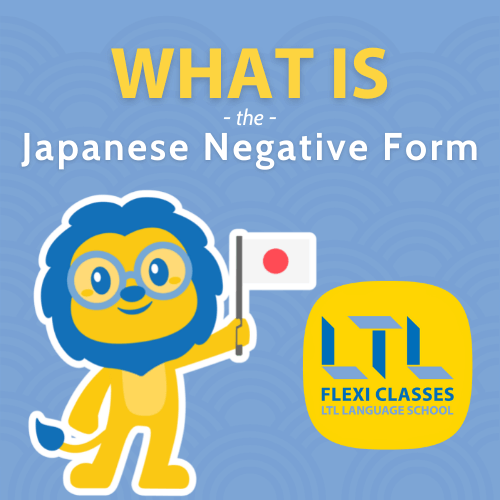Japanese Grammar | The Japanese Negative Form
When there are positives, there are negatives. When there is a presence of something, there is the absence of something!
Don’t worry, we are not getting philosophical here! We are just emphasising why today’s lesson about the Japanese negative form is important!
Up until now, we have studied the basic sentence structures. But we also need to understand the basic negations of a sentence to use in simple conversations.
Today, we will study negation in Japanese.
Negating a sentence is very easy. Have a look for yourself!

Japanese Negative Form | です / Desu Structure
Japanese Negative Form | ある / Aru Structure
Japanese Negative Form | いる / Iru Structure
Japanese Negative Form | い Adjectives
Japanese Negative Form | With Verbs
Japanese Negative Form | FAQ’s
The Japanese Negative Form of です / Desu
This is the most commonly used negation of the Japanese language.
The negation of the です sentence structure is also used for sentences with na adjectives (adjectives ending with な).
| Hiragana | Romaji | Negation in Hiragana | Negation in Romaji | |
|---|---|---|---|---|
| Present / Future Tense | です | desu | ではありません | dewa arimasen |
| Past Tense | でした | deshita | ではありませんでした | dewa arimasen deshita |
Here is an example of a sentence in different forms:
- わたしはがくせいです。
- watashi wa gakusei desu.
- I am a student.
- わたしはがくせいでした。
- watashi wa gakusei deshita.
- I was a student.
- わたしはがくせいではありません。
- watashi wa gakusei dewa arimasen.
- I am not a student.
- わたしはがくせいではありませんでした。
- watashi wa gakusei dewa arimasen deshita.
- I was not a student.
The Japanese Negative Form of ある / Aru
If you’ve been studying Japanese for a bit, you must have gotten used to the verb ある.
The ある ending is used for existence of non-living things.
Here are different forms of ある verb:
| Hiragana | Romaji | Negation in Hiragana | Negation in Romaji | |
|---|---|---|---|---|
| Present / Future Tense | あります | arimasu | ありません | arimasen |
| Past Tense | ありました | arimashita | ありませんでした | arimasen deshita |
Here is an example in all forms:
- そこにしんぶんがあります。
- shinbun ga arimasu.
- There is a newspaper.
- そこにしんぶんがありました。
- shinbun ga arimashita.
- There was a newspaper.
- そこにしんぶんがありません。
- shinbun ga arimasen.
- A newspaper is not there.
- そこにしんぶんがありませんでした。
- shinbun ga arimasen deshita.
- A newspaper was not there.
The Japanese Negative Form of いる / Iru
The いる ending is used for living things.
This ending is also used for present continuous tense. How?
We will see more of this ending when we learn about the て (Te) form. For now, let’s see some basic negations for いる verbs.
| Hiragana | Romaji | Negation in Hiragana | Negation in Romaji | |
|---|---|---|---|---|
| Present / Future Tense | います | imasu | いません | imasen |
| Past Tense | いました | imashita | いませんでした | Imasen deshita |
Here is an example:
- そこにねこがいます。
- neko ga imasu.
- There is a cat.
- そこにねこがいました。
- soko ni neko ga imashita.
- There was a cat.
- そこにねこがいません。
- neko ga imasen.
- A cat is not there.
- そこにねこがいませんでした。
- soko ni neko ga imasen deshita.
- A cat was not there.
The Japanese Negative Form of ii Adjectives
There are special negations used for ii adjectives (adjectives ending with い).
These are also used in in daily conversations where sentences with です or ます endings are not used, with friends and family for instance.
| Hiragana | Romaji | Negative in Hiragana | Negative in Romaji | |
|---|---|---|---|---|
| Present / Future Tense | ~い | ~ii | ~くない | ~kunai |
| Past Tense | ~かった | ~katta | ~くなかった | ~kunakatta |
Here is an example:
- おいしいすし。
- oishii sushi.
- Delicious sushi.
- おいしかったすし。
- oishikatta sushi.
- That sushi was delicious.
- おいしくないすし。
- oishikunai sushi.
- The sushi is not delicious.
- おいしくなかったすし。
- oishi kunakatta sushi.
- That sushi was not delicious.
The Negation Form of Japanese Verbs
You will use various verbs in daily conversations. The below table will help you form sentences in the past, present and future tense.
| Hiragana | Romaji | Negation in Hiragana | Negation in Romaji | |
|---|---|---|---|---|
| Present / Future Tense | ~ます | ~masu | ~ません | ~masen |
| Past Tense | ~ました | ~mashita | ~ませんでした | ~masen deshita |
Here is an example:
- ほんをよみます。
- hon wo yomimasu.
- I read a book.
- ほんをよみました。
- hon wo yomimashita.
- I read a book.
- ほんをよみません。
- Hon wo yomimasen.
- I do not read a book.
- ほんをよみませんでした。
- Hon wo yomimasen deshita.
- I did not read a book.

Are you a Flexi Classes student already?
Learn more about Japanese Negative Forms in the following Flexi lessons:
Verb Conjugation (A1, Chapter 3)
Let’s Go To The Beach (A1+, Chapter 1)
Did You Watch The New Drama Series? (A1+, Chapter 3)
Not a Flexi Student yet?
And that’s it, an introduction to the Japanese negative form!
Not so daunting, right?
Don’t forget to also check these lessons if you want to take your Japanese level a bit further, or if you need to brush up on your skills:
- Japanese particles
- Japanese counters
- How to use adjectives in Japanese
- Japanese basic sentence structure
Have you ever considered joining an online class with a professional teacher?
With Flexi Classes you can study Japanese 24/7 with professional teachers, and even choose your study time and study topic!
Start today with a 3 hour free trial.
FREQUENTLY ASKED QUESTIONS
How to negate a Japanese verb?
To use the Japanese negation form you have to look at what verb is included in your sentence, as the negation form will depend on it.
For example:
The present/future negation of the verb です (desu), is ではありません (dewa arimasen). This form is the most common.
Let’s take the verb ある (aru). Its present/future tense is あります (arimasu), and its present negation form is ありません (arimasen).
To negate most verbs in present and future tense, you’ll need ~ません (masen). The past tense is ~ませんでした (masen deshita).
Check out our full article for examples and more negation sentence structures.
How to negate a Japanese adjective?
The negation of the です sentence structure is also used for sentences with na adjectives (adjectives ending with な).
The present/future negation of the verb です (desu), is ではありません (dewa arimasen). The past tense negation form is ではありませんでした (dewa arimasen deshita).
There are special negations used for ii adjectives (adjectives ending with い).
The present/future negation of い adjectives is ~くない (~kunai). The past tense negation form is ~くなかった (~kunakatta).
Check out our full article for examples of use.
What is the Japanese negation form?
The most common Japanese negation form is the one with the verb です.
The present/future negation of the verb です (desu), is ではありません (dewa arimasen).
The past tense negation form is ではありませんでした (dewa arimasen deshita).
How to create a sentence with a verb in Japanese?
In Japanese, the SOV structure is used:
Subject + Object + Verb.
Remember, all the sentences in Japanese end with a verb.
What is the most basic Japanese sentence structure?
The most basic Japanese sentence structure is:
Subject + は + Object + です.
This sentence structure is used for generalised things or stating facts.
Do you offer online Japanese classes?
Yes we do!
We offer both individual and group classes online, all taught by live professional native teachers.
Classes are available 24/7 on our Flexi Classes platform, and you can choose your level, class type, study time and study topic.
We even offer a free trial for you to try it out!









